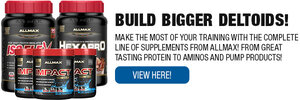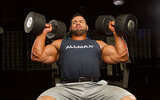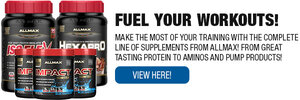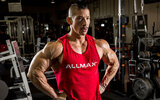01dragonslayer
Ripped
- Jacked Cash
- 495,730
Your shoulders are so important for several reasons.
In terms of function, most of the upper body lifts involve the shoulders in some way.
In regards to your physique, they are the top of that V-taper look and accessorize your entire upper body.
Can you imagine someone with big arms, wide back, thick chest, but small delts? Me neither.
It takes serious intensity and effort to build your delts but it’s also a muscle group that you might not want to spend a lot of time with. This is where supersets come into play.
Nothing beats supersets when it comes to doing a lot of work in little time. The process is simple – pick two exercises, perform them back-to-back with no rest in between, repeat.
The supersets below will help you target all three heads of the shoulder area very effectively.
A key to make supersets as effective as possible is to minimize the time in transition from one movement to the next.
The supersets here are focused around that idea.

Loop a resistance band around a solid object like a rack or machine. Pick a side and perform both of these exercises. The band will help you keep tension at all times but it should be light enough resistance that you don’t have to use excessive force.
Related: Cannonball Delts - The Ultimate 12 Week Shoulder Building Program
Do your best to focus on working the shoulder area. Once you’ve performed both exercises with one side, repeat with the other.
Perform 3 supersets of 20 reps each on these.
On seated dumbbell presses, don’t lock out your arms at the top of the press. This will keep tension on the delts and off of the triceps which take over as you lock out. Make sure your elbows are out to the sides. Keeping them in will slightly recruit your pecs even in a seated position.
Speaking of position, set your adjustable bench to the highest incline possible without being completely upright. This will take pressure off your lower back and help isolate the front delts.

On front plate raises, when you grab the plate, position your hands like you would on a steering wheel. So your hands should be on 10 and 2. When you lift the plate up, raise it until your arms are slightly above parallel with the floor. Going any higher will force recruitment from the traps.
Try to lower the plate as straight down as possible. You might be tempted to lower it until it’s all the way in to your body. Stop just short of this so tension stays on the muscle at the bottom.
Perform 3-4 supersets of 8-10 reps here.
The close grip upright row can be controversial because there are some who believe this movement should be avoided. If you have shoulder issues, find something else. One reason I found that athletes have trouble is they exaggerate the movement.
To use this for the side delts, have an overhand, close grip on the bar you’re using. Make sure it’s light enough for you to feel the muscles work. There should be no swinging or jerking. When you lift up, stop at chest level. You should feel the side delts contract. At this point, go back down.

You’ve done lateral raises with dumbbells but you may never again after trying the standing kettlebell lateral raise. Kettlebells have all of the weight at the bottom as opposed to a dumbbell that surrounds the hand with the weight.
If you hold the kettlebell at the top of the handle and attempt to lift the weight out to your side without letting the kettlebell drop, your side delts will be forced to do serious work. In other words, when you lift the kettlebell, it should be horizontal at the top of the rep. This also means performing the negative will be tougher which is what you want in order to make the greatest gains.
Perform 3-4 sets of 8-10 reps again with this superset.
Related: Super Shoulder Striations - Get Ripped Shoulders with this Workout
For face pulls, attach a long rope to an upper cable pulley. You can separate the handles of the rope as you pull it in so you have a longer range of motion. This means you can squeeze the rear delts a little harder and will get a longer stretch when you perform the negative. Make sure you stand far enough back that the weights on the pin won’t touch the rest of the stack.
For cable bent over lateral raises, you can either work with both lower pulley cable handles or you can isolate each side by performing your set one side at a time. Either way, when you pull the cable handle across, pull like you’re trying to touch the wall at your side and then pull up until your arm is up past shoulder level.
Make sure your shoulders are over your hands as you perform your set. You don’t want your back to join the party. Keeping your shoulders over the handles will target the rear delts.
For this last superset, perform 3-4 supersets of 10-12 reps.

You need to take a serious look at your physique and decide what your greatest priority is. What needs the most work? So if width is your priority and you feel your side delts need the most attention, you should start with that superset pairing and do four supersets here.
What area is the strongest part of your shoulders? If it’s your front delts then you can work that area last and commit 3 supersets to that cause. So that leaves your rear delts as being in between.
You can decide for yourself whether three or four rounds would take care of those. So your workout might look like this.
Ultimately, your goal is to have a strong and complete pair of shoulders and these supersets can help you make that goal a reality.
In terms of function, most of the upper body lifts involve the shoulders in some way.
In regards to your physique, they are the top of that V-taper look and accessorize your entire upper body.
Can you imagine someone with big arms, wide back, thick chest, but small delts? Me neither.
It takes serious intensity and effort to build your delts but it’s also a muscle group that you might not want to spend a lot of time with. This is where supersets come into play.
Nothing beats supersets when it comes to doing a lot of work in little time. The process is simple – pick two exercises, perform them back-to-back with no rest in between, repeat.
The supersets below will help you target all three heads of the shoulder area very effectively.
A key to make supersets as effective as possible is to minimize the time in transition from one movement to the next.
The supersets here are focused around that idea.

1. Internal and External Rotations with Bands
Anytime you’re training shoulders the rotator cuffs should be the first area you focus on. So many lifters over the years developed shoulder issues and it is because they don’t focus on this area which is so vital to your overall performance.Loop a resistance band around a solid object like a rack or machine. Pick a side and perform both of these exercises. The band will help you keep tension at all times but it should be light enough resistance that you don’t have to use excessive force.
Related: Cannonball Delts - The Ultimate 12 Week Shoulder Building Program
Do your best to focus on working the shoulder area. Once you’ve performed both exercises with one side, repeat with the other.
Perform 3 supersets of 20 reps each on these.
2. Seated Dumbbell Press and Front Plate Raise
The front delts are involved in a lot of pressing so if you train heavy with chest, you might not have issues with weak delts but you should focus on training them on their own time anyway. The front head is also responsible for lifting your arms up straight in front of you. These two exercises will focus on both functions.On seated dumbbell presses, don’t lock out your arms at the top of the press. This will keep tension on the delts and off of the triceps which take over as you lock out. Make sure your elbows are out to the sides. Keeping them in will slightly recruit your pecs even in a seated position.
Speaking of position, set your adjustable bench to the highest incline possible without being completely upright. This will take pressure off your lower back and help isolate the front delts.

On front plate raises, when you grab the plate, position your hands like you would on a steering wheel. So your hands should be on 10 and 2. When you lift the plate up, raise it until your arms are slightly above parallel with the floor. Going any higher will force recruitment from the traps.
Try to lower the plate as straight down as possible. You might be tempted to lower it until it’s all the way in to your body. Stop just short of this so tension stays on the muscle at the bottom.
Perform 3-4 supersets of 8-10 reps here.
3. Close Grip Upright Row and Standing Kettlebell Lateral Raise
The lateral head of the shoulders are the primary muscle in play when you lift your arms straight up to your sides. They will also work if you’re pulling anything straight up with your hands close together. If you want to look wide, then you have to give this portion your undivided attention. For this one you’ll use a barbell and kettlebells.The close grip upright row can be controversial because there are some who believe this movement should be avoided. If you have shoulder issues, find something else. One reason I found that athletes have trouble is they exaggerate the movement.
To use this for the side delts, have an overhand, close grip on the bar you’re using. Make sure it’s light enough for you to feel the muscles work. There should be no swinging or jerking. When you lift up, stop at chest level. You should feel the side delts contract. At this point, go back down.

You’ve done lateral raises with dumbbells but you may never again after trying the standing kettlebell lateral raise. Kettlebells have all of the weight at the bottom as opposed to a dumbbell that surrounds the hand with the weight.
If you hold the kettlebell at the top of the handle and attempt to lift the weight out to your side without letting the kettlebell drop, your side delts will be forced to do serious work. In other words, when you lift the kettlebell, it should be horizontal at the top of the rep. This also means performing the negative will be tougher which is what you want in order to make the greatest gains.
Perform 3-4 sets of 8-10 reps again with this superset.
4. Face Pull and Cable Bent-Over Lateral Raise
Your rear delts are involved in some of your back movements but just like the front delts, you’d get the best results if you focus on them individually. Staying with the idea of working with two exercises that are close together, we’re going to the cable station. Cables allow you to keep tension on the area you’re working and you can stay in a fixed path when performing reps.Related: Super Shoulder Striations - Get Ripped Shoulders with this Workout
For face pulls, attach a long rope to an upper cable pulley. You can separate the handles of the rope as you pull it in so you have a longer range of motion. This means you can squeeze the rear delts a little harder and will get a longer stretch when you perform the negative. Make sure you stand far enough back that the weights on the pin won’t touch the rest of the stack.
For cable bent over lateral raises, you can either work with both lower pulley cable handles or you can isolate each side by performing your set one side at a time. Either way, when you pull the cable handle across, pull like you’re trying to touch the wall at your side and then pull up until your arm is up past shoulder level.
Make sure your shoulders are over your hands as you perform your set. You don’t want your back to join the party. Keeping your shoulders over the handles will target the rear delts.
For this last superset, perform 3-4 supersets of 10-12 reps.

How to Develop Your Program
We’ve already established that you should focus on the rotator cuff supersets before doing anything else. Now we need to figure out the rest of the workout.You need to take a serious look at your physique and decide what your greatest priority is. What needs the most work? So if width is your priority and you feel your side delts need the most attention, you should start with that superset pairing and do four supersets here.
What area is the strongest part of your shoulders? If it’s your front delts then you can work that area last and commit 3 supersets to that cause. So that leaves your rear delts as being in between.
You can decide for yourself whether three or four rounds would take care of those. So your workout might look like this.
- Rotator Cuff Superset – 3 supersets
- Lateral Delts – 4 supersets
- Posterior Delts – 3-4 supersets
- Front Delts – 3 supersets
Ultimately, your goal is to have a strong and complete pair of shoulders and these supersets can help you make that goal a reality.

